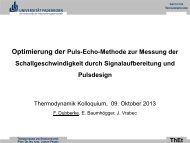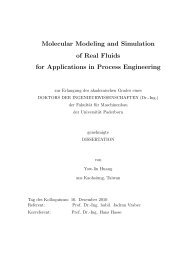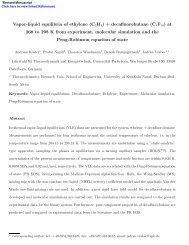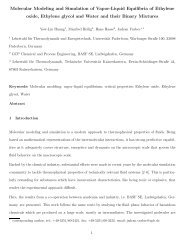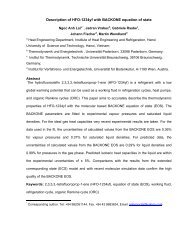ms2: A Molecular Simulation Tool for Thermodynamic Properties
ms2: A Molecular Simulation Tool for Thermodynamic Properties
ms2: A Molecular Simulation Tool for Thermodynamic Properties
You also want an ePaper? Increase the reach of your titles
YUMPU automatically turns print PDFs into web optimized ePapers that Google loves.
Q = 2aq. The electrostatic interaction between two linear point quadrupoles with the momentsQi and Qj at a<br />
distancerij is given by [43, 54]<br />
u QQ<br />
ij (rij,θi,θj,φij,Qi,Qj) = 1<br />
4πε0<br />
3QiQj<br />
4 r5 ij<br />
<br />
1−5 (cosθi) 2 +(cosθj) 2 −15(cosθi) 2 (cosθj) 2 +<br />
2 2 sinθisinθj cosφij −4cosθicosθj ,<br />
where the anglesθi,θj andφij indicate the relative angular orientation of the two point quadrupoles, as discussed<br />
above. Note that no long range correction is necessary <strong>for</strong> this interaction type if the fluid is isotropic.<br />
Reaction field method. The truncation of interactions between first and second order electrostatic sites leads to<br />
errors that need to be corrected. The reaction field method [34, 55] is implemented in <strong>ms2</strong> <strong>for</strong> this task, being<br />
widely used and well accepted [56, 57]. Its advantages are accuracy and stability, while requiring little compu-<br />
tational ef<strong>for</strong>t compared to other techniques like Ewald summation [58]. However, it is limited to electro-neutral<br />
systems, thus<strong>ms2</strong> is currently restricted to electro-neutral molecules. The basic assumption of the reaction field<br />
method implemented in<strong>ms2</strong> is that the system is sufficiently large so that tinfoil boundary conditions (εs → ∞)<br />
are applicable without a loss of accuracy. This is the case <strong>for</strong>N ≥ 500 [59, 60, 61, 62].<br />
4.6. Cut-off modes<br />
<strong>ms2</strong> supports two different cut-off modes: the site-site cut-off and the center of mass cut-off. The site-site cut-off<br />
mode explicitly considers the interactions between all sites that are within a distance ofrc. Beyondrc, the long-<br />
range contributions to the energy and pressure are estimated by analytical functions assuming a homogeneous<br />
fluid [29]. A disadvantage of the site-site cut-off arises, if molecular models contain point charges. In many cases<br />
close to rc, molecules are only partially considered in the explicit calculation, cf. Figure 3. The point charges<br />
within the cut-off radius may be unbalanced so that an overall charge within the cut-off sphere might occur. For<br />
this condition, the reaction field is not valid.<br />
A more robust alternative is the center of mass cut-off mode. It considers all interaction sites of different<br />
molecules explicitly, if their molecular centers of mass are within the cut-off radius. The long-range contri-<br />
butions beyond rc due to LJ interactions are approximated by the <strong>for</strong>mulations of Lustig [63]. Note that the<br />
computational advantage of the center of mass cut-off mode increases with the number of sites per molecule.<br />
4.7. Monte-Carlo algorithm<br />
<strong>Thermodynamic</strong> properties are determined by MC simulation via a Markov chain of molecular configurations.<br />
In <strong>ms2</strong>, this Markov chain is generated by executing a loop of NMC moves per configuration, where NMC is<br />
defined by<br />
NMC = 1<br />
3<br />
(18)<br />
N<br />
Ni,DGF . (19)<br />
i=1<br />
Here, N represents the number of molecules in the system and Ni,DGF is the number of degrees of freedom<br />
of molecule i. For MC simulations, three different moves are implemented in <strong>ms2</strong>, translational and rotational<br />
15



